Abstract
The development of Industry 4.0 revolutionising the concept of automation and digitisation in an organisation poses a huge challenge in employee knowledge and skills to cope with the huge leap from Industry 3.0. The high-level digitisation of an organisation requires the workforce to possess higher order thinking skills (HOTS) for the changing job roles matching the rapid technological advancements. The Education 4.0 framework is aimed at supporting the Industry 4.0 skills requirement not only in digital technologies but more towards soft skill development such as collaboration and lifelong learning. However, the education sector is also facing challenges in its transition from Education 3.0 to Education 4.0. The main purpose of the paper is to propose an Agile approach for developing smart classroom teaching strategies that foster employee adaptability with the new learning paradigm of upskilling in line with Industry 4.0. By adopting an exploratory research methodology, the pilot study investigates the implementation of the proposed Agile approach in a higher education setting for graduates to achieve HOTS using smart classroom teaching strategies. This study uses learning theories such as experiential learning in smart classroom environments to enhance students’ HOTS individually as well as collaboratively in an Agile iterative manner. This is the first empirical study carried out for graduates specialising in the Business Analytics skillset required for Industry 4.0. The findings of the pilot study show promising results that pave the way for further exploration and pedagogical insights in this research direction.
1. Introduction
The rapid advancement of digital technologies is resulting in the fourth industrial revolution known as Industry 4.0 [1,2]. The third industrial revolution, or Industry 3.0, saw the use of information technology (IT) to automate processes, whereas Industry 4.0 is about enhancing the connectivity with cyber physical systems and the automation with big data. With new technology enablers such as IoT (Internet of Things), big data analytics, cyber security, additive manufacturing, augmented reality, cloud data management and computing, Industry 4.0 is expected to bring about significant changes across all industries, including the education sector [3,4]. The high level of automation and digitalisation poses several challenges for enterprises to not only manage their transition towards higher value technologies, applications and processes but also to upskill their human resources [5,6]. An entirely new way of integrating IoT is required with intelligent computer algorithms learning to control the robotics remotely [7]. While much importance is given to technological changes in enterprises, there is a scarcity of research in developing an appropriate approach to the education processes required for the Industry 4.0 workforce due to the huge transition required from Industry 3.0 [8,9,10].
The Industry 4.0 wave is not merely the application of the latest technologies but rather requires the integration of multi-dimensional social and technical systems to meet the business goals of an organisation. Hence, the skillset of the workforce needs to be enhanced as employees are required to be self-adaptive to these changing multiple dimensions with lifelong learning capabilities for a successful implementation of Industry 4.0. With the advancement in Industry 4.0, the challenge for the existing education and training systems is to ensure that all industrial sectors make the best use of the digital transformation by supporting it with a completely new employee skillset across their entire business value chain. Different workplace skills are required in industry at all levels of task performance with an appropriate mix of both digital and business-specific skills and competencies [11]. To meet Industry 4.0 skill requirements, Education 4.0 is aimed at preparing the new graduates and workforce to focus on problem-solving with emerging technologies and innovative teaching strategies [9,11]. Education 4.0 is a revolution with a new paradigm of training offerings that are required to be facilitated via flexible educational environments rather than traditional teaching models [12]. In the past, business graduates gained business knowledge and skills, while information technology (IT) graduates focused on acquiring technical skills. It is expected that Education 4.0 would be able to provide the necessary training to meet the skillset requirements of Industry 4.0.
Education 3.0 refers to a variety of ways to integrate technology into learning, while Education 4.0, with a learner-centric focus, transforms the future of education through advanced technology and automation aligned to Industry 4.0. Today, enterprises expect fresh graduates to be work ready with a combination of not only business and technical skills but also lifelong learning skills necessary for job effectiveness in their new and higher-skilled roles for Industry 4.0 [5]. One such job role falls under a specialised discipline of Business Analytics, which is the focus of study in this paper.
Recent studies show that a workforce skill gap exists in Business Analytics that covers subject areas such as business analysis, data analytics, business intelligence and enterprise-wide information systems impacting a number of key industries [10]. An analysis of skills shortage amongst professionals in Business Analytics reveals a lack of importance given to the development of higher-order problem-solving skills necessary to address real-life complex business situations due to the current Industry 4.0 wave [11,12]. Developing the necessary technical and business-related data analytics skills encompasses multi-domain expertise. This requires learners’ deep engagement with advanced theories and practical concepts that can be integrated across multiple related subject areas [13,14]. To address this, Education 4.0 recommends a paradigm shift in designing learner-centric teaching strategies for Business Analytics graduates with an emphasis on achieving higher order thinking skills (HOTS). Therefore, an innovative approach to promote higher levels of cognitive skills is warranted to bridge the skill gap in the Business Analytics subject domain for upskilling the Industry 4.0 workforce [15,16,17].
According to Bloom’s taxonomy of learning, the lower levels of cognitive skills provide a base for the higher levels of skills required for industry [18]. Higher order skills include analysing, evaluating and creating or synthesising and require mastery of previous levels, such as understanding and applying knowledge to familiar or new situations [19]. Higher order thinking involves breaking up complex problems, establishing relationships among ideas and making judgements in producing a new solution or idea creatively. Figure 1 provides Bloom’s revised taxonomy and the three HOTS (Analysing, Evaluating and Creating), which forms the premise for our study on improving HOTS in the Business Analytics domain for preparing work-ready IT graduates for the Industry 4.0 revolution [20].
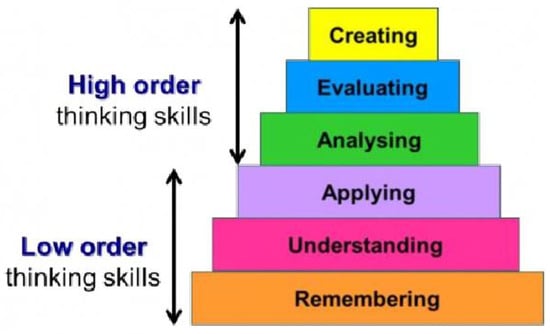
Figure 1.
Bloom’s revised taxonomy and HOTS.
Higher education institutions have reported that many students pursuing Business Analytics exhibit a gap in their active classroom engagement in their studies [21]. This has been attributed to the lack of application of HOTS that is necessary for an in-depth understanding of multi-domain concepts and application of theory to complex business problems faced with the Industry 4.0 wave. This gap in student skill achievement is even more prominent with the recent move to fully online learning [22,23]. This paper takes the first steps to address such gaps in students’ creative thinking skills and other HOTS using an Agile approach for Education 4.0. Our focus is to provide innovative teaching strategies in smart classroom environments (use of online learning tools and applications) in the subject areas of Business Analytics specialisation to enhance students’ HOTS. The pilot study aims to evaluate the impact of smart classroom activities on student engagement and performance. It includes a comparative analysis of “before and after” delivery and the effect on overall student learning towards achieving the required Business Analytics skillset. This was achieved by applying quantitative and qualitative instruments such as surveys completed by students before and after the smart classroom learning activities as well as focus group discussions of the researchers compared with the Lecturer’s observations during each activity.
This paper is organised as follows. Section 2 provides a literature review of learning theory such as experiential learning, its application in smart classrooms, as well as gaps in research studies, especially in building a Business Analytics skillset for Industry 4.0. With an aim to take initial steps to fill the gap in the literature, an Agile approach is proposed for incorporating smart classroom strategies in Section 3. A practical implementation of the proposed method in developing learning activities in smart classroom environments and the findings of the pilot study are reported in Section 4. Finally, Section 5 gives the concluding remarks and future work of this ongoing research.
2. Literature Review
For several decades, active student learning in higher education has been researched with learning theories. Kolb’s experiential learning theory is the “process whereby knowledge is created through the transformation of experience” (p. 38), with each stage being mutually supportive of and feeding into the next stage [24]. Recent studies using experiential learning for competency building with technologies have been conducted in traditional classrooms only [16,21]. One such study has reported an increase of 29% in students’ level of attainment of competencies in lean-thinking using experiential learning [25]. While such studies have reported a positive increase in student engagement or an increase in student performance, they have not explored smart classroom environments for Business Analytics subjects with the focus of enhancing students’ HOTS as an Agile teaching strategy of Education 4.0.
Generation-Z (Gen-Z) students, who were born between 1995–2012, are being perceived by higher educators around the world as being non-interested and disengaged in learning these days [26]. Similarly, higher education students expect more visualised learning methods to activate their interest and motivate them for improved learning outcomes [26,27]. According to Cervi [27], social media platforms such as Tik Tok should be scientifically experimented with to understand how these applications can be used to increase learning in higher education. Recent research has reported that digital native Gen-Z learners adopt a skim reading of the web, and a decline in students’ cognitive capacity has been observed, impeding their higher order learning and critical analysis skill development [22]. In another report, Manzoni et al. [28] found that Gen-Zers highly prefer combining abstract conceptualisation and reflective observation identifying a need for interactive experience-based engagement for learning. In this digital era of Industry 4.0, the use of smart classroom environments is becoming more common and supports Gen-Z learning engagement. It is also important for higher educators to learn, develop and apply digital technologies that are student-centred to enhance communication and improve their teaching process [26]. These applications and tools are also being promoted toward facilitating HOTS in blended learning settings.
For more than a decade, many research investigations have been in educational technology that focuses on digital innovations, which have studied the impact of transformations in the physical classroom environments [14,29,30]. Advancements in IT have generated diverse scenarios, including online teaching that requires innovative teaching processes and strategies that are adapted to the needs of Gen-Z learners [31]. Recent research has reported that digital native Gen-Z learners adopt a skim reading of the web, and a decline in students’ cognitive capacity has been observed, impeding their higher order learning and critical analysis skill development [22]. In this digital era of Industry 4.0, the use of smart classroom environments (use of online learning tools and applications) is becoming more common and supports Gen-Z learning engagement. These applications and tools are also promoted as facilitating HOTS in blended learning settings. There is, however, a scarcity of research exploring how such smart classroom teaching strategies are applied for demonstrable enhancement of students’ HOTS [23,32,33]. Some attempts have been made in specific subject topics within a restricted environment that has resulted in siloed effects [34,35]. A multi-disciplinary approach was adopted to look at problems faced by the educational professionals and possible solutions in Education Technology [29]. However, there is a scarcity of research studies exploring the problem with the focus on bridging the learning gaps using a holistic approach for Education 4.0 [36,37]. This forms the key motivation of our research study.
Leveraging IT as a tool to innovate teaching methods and practices could open up didactic strategies for improving the quality of teaching and learning processes [30]. The purpose is to develop learner-centric strategies for promoting the interest and motivation of students in classroom environments. However, the key challenge in the integration of education and training processes needs to be addressed with the current digital transformation of classroom environments [28]. With the changes leading us into blended learning approaches, it is important to develop a model of learning assessment in a smart classroom environment. While some model approaches are available in the literature, there is a need to explore this in current learning contexts applied to Business Analytics skill development for Industry 4.0 [38,39]. Further, this is the first project of its kind to employ several tools in several subjects with an integrated approach towards achieving HOTS in general and, more specifically, in the Business Analytics suite of subjects.
Overall, the extant literature in information technology education lacks research that combines smart classroom environments in multiple related subjects through active learning, such as experiential learning for building competencies in the Business Analytics domain. In particular, there is a scarcity of studies exploring smart classroom environments for enhancing students’ HOTS in solving complex business problems using data analytics within the framework of Education 4.0. This research attempts to take initial steps to fill this gap in the literature by exploring innovative teaching strategies in smart classroom environments for HOTS in this knowledge domain. Further, an Agile approach is proposed in the pilot study for promoting our specialisation in a stimulating educational environment for competency building of Business Analytics skillset to meet the requirements of Industry 4.0. This Business Analytics skillset is becoming increasingly important in the post-COVID-19 scenario. The demand for such skillsets in the industry is high due to more organisations needing to make informed and better decisions based on their data and analytics. Using smart classrooms along with Agile teaching approaches supports students’ learning and upskilling more effectively through a fully online teaching model as well as a hybrid or blended teaching model being predominantly adopted in this post-COVID-19 era. The change from fully online to hybrid or blended learning will help the students develop communication skills and become more tech-savvy by needing them to interact with teachers and their peers via face-to-face, online or mixed modes.
Due to the sudden onset of the COVID-19 pandemic (COVID), during the pandemic and post-COVID, educators faced challenges in online learning and delivery due to a lack of research studies in this topical domain [40,41]. Some of the emerging research themes in the extant literature on higher education (HE) online learning pre-COVID, during COVID, and post-COVID are highlighted in the literature. Firstly, studies conducted in pre-COVID-19 times are mainly topics aligned with students and satisfaction in HE online learning [42]. Secondly, research during COVID mainly focused on studying the challenges faced due to: (i) the lack of different digital platforms to provide support for learners, (ii) learning management system (LMS) not being user-friendly, (iii) educators’ lack of resources for teaching online from home [42]. Thirdly, post-COVID studies show that educators expected changes in education practices to increase educator digital literacy and adapt courses for online learning [43,44]. Lastly, a meta-analysis of post-COVID research shows a growing trend in online learning using videos and Web 2.0 technologies for delivering courses [45]. Overall, COVID has created many challenges faced by educators where the lack of digital resources and capabilities is hindering effective online learning. Similarly, the lack of Web 2.0 literacy is hindering the adaptation of traditional courses to online course delivery.
In this paper, the above-mentioned gaps in literature will be the focus of the pilot study. There is a need to address the following problems identified:
- (1)
- Skill-gap in Business Analytics workforce for Industry 4.0 [10];
- (2)
- Scarcity of graduates with higher-order thinking skills (HOTS) to problem solve and deal with changing business situations due to rapid advancements of Industry 4.0 [18];
- (3)
- Difficulty in designing multi-domain teaching strategies with Education 4.0 framework to support lifelong and sustainable learning skills. This requires teachers’ expertise in not only the multi-disciplinary subject domain of Business Analytics with sufficient industry experience but also in pedagogy and learning theories to facilitate learners’ skill development effectively [11].
A learning assessment model using multiple smart classroom teaching strategies is proposed that adopts an Agile approach for implementing strategies for Education 4.0. This includes innovative classroom strategies using online smart tools for HOTS development in IT students by incorporating experiential learning, stimulation and exploratory activities in a suite of Business Analytics subjects.
3. Research Methodology and Agile Approach
This section describes the research methodology adopted for the pilot study. Since the research questions considered in this study have not previously been studied in depth, an exploratory research methodology is appropriate to obtain a better understanding of the problem of enhancing HOTS in Business Analytics. An Agile approach for implementing a pedagogical and practice-focused model using smart classroom strategies to enhance HOTS for students in a higher education setting. The three steps to conduct exploratory research in this pilot study are shown in Figure 2. A qualitative approach is employed with an iterative development of the learning activities in smart classroom environments for teaching Business Analytics subjects.
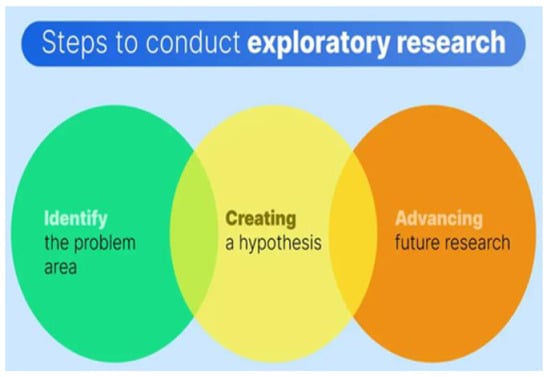
Figure 2.
Exploratory research steps.
In this pilot study, the Agile model is adopted to develop innovative learning activities in smart classroom environments by using online collaborative tools for Business Analytics subjects in a higher education setting. In particular, the proposed Agile model is used to develop and evaluate novel and contemporary smart classroom teaching strategies for improving HOTS for IT graduates in the Business Analytics domain of specialisation.
An Agile iterative development methodology was formulated for this pilot study, as shown in Figure 3. It has the necessary stages in each iteration or cycle that allows for adapting the smart classroom activities and student learning processes. Such a continuous improvement of teaching strategies would help in improving the quality of student learning. Agile development methodology is typically used in software development approaches for “collaborative self-organising teams dynamically adjust to changing customer requirements” ([46], p. 2). In this pilot study, Agile methodology is used to aid the researchers/Lecturers in applying a number of smart classroom environments for designing new teaching strategies in order to adjust to student learner requirements over cycles of improvement within and across Business Analytics subjects.
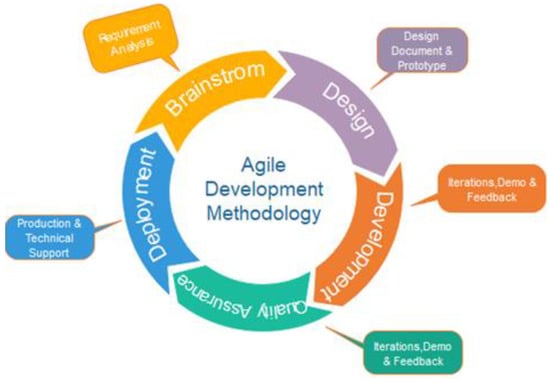
Figure 3.
Agile iterative approach for smart classroom teaching strategy development.
To enable the Agile approach, the Lecturers first problematise as well as identify a learner-centred framework for teaching to arrive at a learning assessment model in Business Analytics subjects. This is facilitated by mapping the appropriate HOTS (Analysing, Evaluating and Creating) with the learning activities. Weekly brainstorming among the Lecturers helps in sharing feedback gained from the student learning activities and data findings. Such an Agile approach is employed to iteratively develop innovative teaching strategies with smart classroom tools to support the integrated Business Analytics skill development. Teaching strategies are adapted and evolved based on Lecturers’ feedback gained from smart classroom teaching activities. Results and feedback from such smart classroom delivery are shared in regular meetings with internal members and external experts of the project team. The purpose is to improve the teaching strategies through the feedback loop of the Agile process, which is adopted for the research project development. Figure 4 shows a mapping of the Agile iterative process with students’ HOTS development using different smart classroom activities.

Figure 4.
Agile framework mapping for HOTS development using smart classroom tools.
The details of the processes adopted in the experimental study for improving HOTS for IT graduates in the Business Analytics domain of specialisation are given in the next section. It also describes the practical implementation of our proposed Agile approach in developing and experimenting with various contemporary smart classroom teaching strategies in two subjects as a pilot study.
4. Implementation of Agile Approach in Smart Classrooms
Prior to the implementation of our proposed Agile approach for experimenting with smart classroom tools, the Lecturers had adopted traditional methods using a case study approach for teaching subjects in Business Analytics specialisation in a higher education setting. IT students in this specialisation were taught to apply theories to analyse, evaluate and model data, business processes and information systems to solve business problems. Some Business Analytics subjects had incorporated activities using Kolb’s experiential learning theory that adopts the process of knowledge creation through the transformation of experience, with each stage being mutually supportive of and feeding into the next stage [35,36]. With the advancements in big data, data-driven analytics aided by software tools such as SAS have been employed in the specialisation subjects [37,39]. However, these teaching strategies are not sufficient to meet organisational skill demands in this fast-paced techno-business domain of Industry 4.0 [38,47]. Further, with the concept of Education 4.0 and an emphasis on lifelong learning of the workforce to meet the skill required for Industry 4.0, learner-centric teaching strategies were explored using smart classroom online tools [48,49].
The initial implementation phase of this research work involves learner-centric modelling and designing of innovative teaching strategies using smart classroom environments to facilitate experiential learning for enhancing HOTS in Business Analytics skill development. Through our proposed Agile approach, the practical implementation of such learner-centric teaching activities aims to increase student engagement and improve overall performance in the inter-related subjects under this specialisation. The discovery phase involves gaining deeper insights into digital technologies that could enhance lecturer competency in designing such innovative teaching strategies and experiential learning activities in smart classroom environments. Summary of student engagement, graphical simulations, business process modelling and visual aided data analysis using smart classroom teaching strategies form key inputs in building graduate competencies for solving current and future business problems. Qualitative and quantitative comparison of the impact on student engagement and student performance “before and after” delivery of smart classroom activities includes the effect on overall subject engagement, performance and other program quality data [50,51]. A collective analysis across various subjects for an integrated effect under Business Analytics subjects is aimed to provide more insights into this problem domain.
Lecturers’ observations through smart classroom activities “before and after” are compared through a two-phase iterative process as shown in Figure 5 for implementing our Agile approach. Attaining Lecturers’ qualitative feedback is guided by an inductive reasoning process: (i) exploring a phenomenon, (ii) identifying themes and patterns and (iii) creating a conceptual framework. Several evaluation measures that provide quantitative and qualitative feedback were considered in this pilot study. These were based on student engagement (anonymous summarised polls, etc.), student learning observations, lecturer feedback of assignments/projects submitted by students, overall subject performance, as well as integrated performance in the Business Analytics subjects. In this pilot study, two Business Analytics subjects, namely Business Analysis (Subject 1) and Enterprise Resource Planning (Subject 2), were investigated with smart classroom activities using our two-phase Agile approach. Table 1 gives a sample questionnaire used for conducting a self-evaluation of students before and after a smart classroom activity. Figure 6, Figure 7, Figure 8, Figure 9, Figure 10, Figure 11, Figure 12 and Figure 13 provide sample findings from the pilot study on the smart classroom teaching strategies that form part of our ongoing research work.

Figure 5.
Two-phase iteration for implementing smart classroom teaching activities.

Table 1.
Sample student self-evaluation questionnaire.
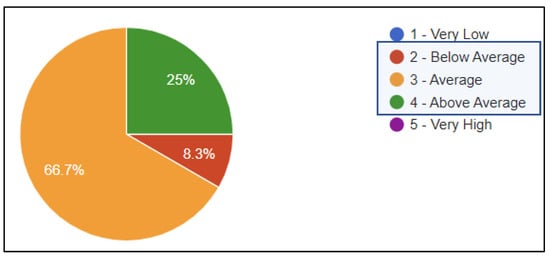
Figure 6.
Students’ analysing skills before 1st smart classroom activity (Subject 1).
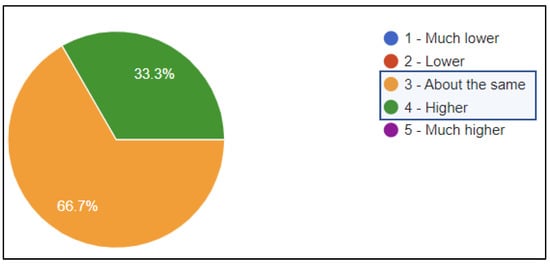
Figure 7.
Students’ analysing skills after 1st smart classroom activity (Subject 1).
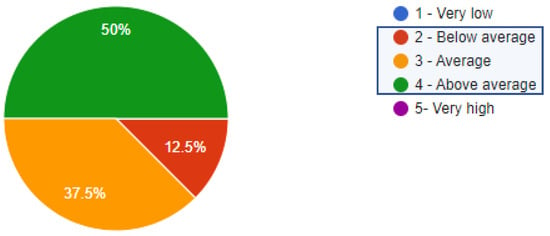
Figure 8.
Students’ analysing skills before 2nd smart classroom activity (Subject 2).
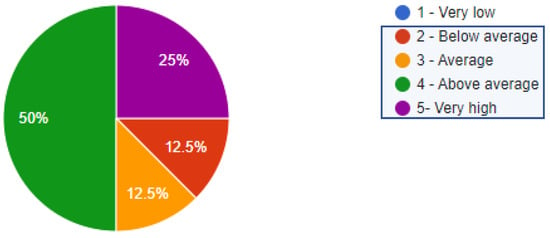
Figure 9.
Students’ analysing skills after 2nd smart classroom activity (Subject 2).

Figure 10.
Students’ analysing skills before experiential learning in smart classroom (Subject 1).

Figure 11.
Students’ creating skills after experiential learning in smart classroom (Subject 1).
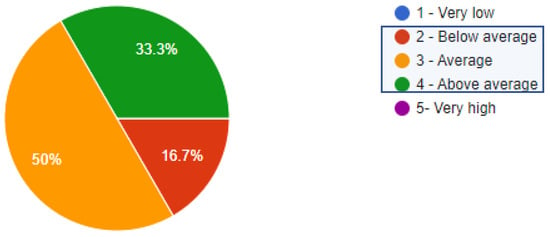
Figure 12.
Students’ creating skills before last smart classroom activity (Subject 2).
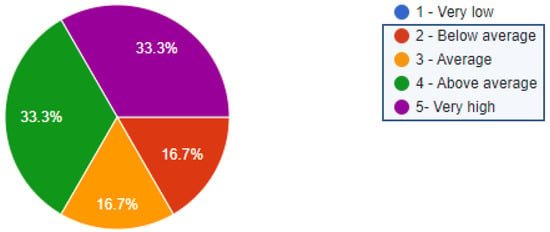
Figure 13.
Students’ creating skills after last smart classroom activity (Subject 2).
The results of students’ self-evaluation for achieving one of the HOTS, namely analysing skills, are shown in Figure 6, Figure 7, Figure 8 and Figure 9. Students rated their skill achievement before and after each of a set of four smart classroom learning activities experimented for two subjects chosen under the Business Analytics domain. A Likert scale of 1 to 5 was adopted to capture the students’ learning activity outcomes in this pilot study. The first learning activity in Business Analysis (Subject 1) using smart classroom online tools such as MIRO and Vizologi was aimed to develop students’ ability to analyse the workflow of an end-to-end business process of a given case study so that they could recommend, monitor and evaluate changes to the workflow. The findings show that our smart classroom teaching strategy had successfully facilitated the improvement of students’ analysing competency as they acquired the enhanced capability to draw connections among ideas. The results obtained in developing the analysing skills using smart classroom activities for Enterprise Resource Planning (Subject 2) were quite similar though a group of students still remained in the ‘Below Average’ level, while some students even progressed to ‘Very High’ levels as shown in Figure 9. Further, with the experiential learning exercise designed in the smart classroom activity of Subject 1, Figure 10 and Figure 11 show an improvement in student motivation to actively engage in creating a SWOT (Strength–Weakness–Opportunity–Threat) analysis artefact. An advanced smart classroom activity was developed following our Agile two-phase iterative approach (Figure 5) by improving the process through feedback gained in the initial activity. Our approach aided in the teaching enhancement for designing and administering the smart learning activities for one of the HOTS, namely creating skills, and students’ results are shown in Figure 11. In this experiential learning exercise, students were required to engage collaboratively using a smart classroom tool to develop a business process re-engineering model using an industry-standard modelling technique taught based on the Business Analysis Body of Knowledge (BABOK) guidelines. Similarly, Subject 2 results on creating skills of HOTS show improved progress at ‘Very High’ levels as perceived by the students (Figure 12 and Figure 13).
The implementation of our Agile approach in our ongoing research involves the use of a variety of online collaboration tools. We have developed smart classroom teaching strategies using online software tools such as MIRO for interactive whiteboard collaboration, Mentimeter for interactive polling, Vizologi for business flows, business process modelling and visualisation, etc. Our key finding is that as technologies evolve in the use of big data analytics in solving complex business problems, we could adopt such software tools to improve the classroom engagement of Gen-Z learners [52]. Using an Agile iterative approach, we have demonstrated how innovative teaching strategies designed with such online tools could effectively assist students in collaborating and achieving the necessary HOTS required in Industry 4.0. Another key finding is that a combination of smart classroom environments with learning activities that focus on integrating the concepts among various related subjects can result in filling the gap found in the workplace with the necessary Business Analytics skillset.
A comparative analysis of the results from Figure 6, Figure 7, Figure 8 and Figure 9 between the smart classroom activities in two subjects of Business Analytics shows that there is a perceived increase from 0 to 25% in students’ self-assessment for the ‘High Level’ cognitive (‘Analysing’) skill achievement. The improvement is also evident as the activities are refined from one subject to the next. Similarly, there is a rise in terms of students’ (‘Creating’) skills by comparing Figure 10, Figure 11, Figure 12 and Figure 13 with an achievement of 33% ‘High Level’ in the after-activity survey as compared to 0% rated in the before activity survey.
Lecturer’s observations during the activity in the smart classroom environment were taken as qualitative feedback, and after the data collection, the student learning patterns were compared. Students were more willing to participate in the activity and engage interactively with the Lecturer and other students through a fun and interactive platform and learning activities. Overall, the tools used in the activity helped the students to enhance their HOTS skills (analysing, evaluating, and creating). Students were able to analyse the concepts learned, research and compare other concepts in the same topic as an evaluation exercise and create their own perspectives to present and share their own learning with the whole class. The entire learning process of a student, individually as well as collectively, could be shared using online software tools such as MIRO and Vizologi.
The scope of this paper is limited to a trial pilot study to design and evaluate a smart classroom framework for teaching a couple of subjects within the Business Analytics domain as a specialisation in the Bachelor of IT program. A smart classroom framework proposed and implemented in this study is based on its qualitative effectiveness in facilitating experiential learning activities and supporting consistency in a student-centred learning experience and active engagement in the Business Analytics subjects. Future work will cater to the quantitative analysis to support our findings. HOTS that are applicable for other specialisations in order to arrive at possible generalisations. This could lead to evolving a generalised smart classroom framework for all disciplines as future research and extensions of this pilot study.
5. Conclusions
This paper proposed and experimented with an Agile iterative approach to incorporate innovative teaching strategies using collaborative tools online. In order to overcome current low levels of student engagement in classrooms and in collaborative group work, new teaching approaches were formulated leveraging technological advancements for blended learning paradigms of Education 4.0. In particular, this study focused on the multi-disciplinary domain of the Business Analytics skill gap in preparing graduates for the workforce of Industry 4.0. Experiential learning via smart classroom environments to capture parallels that exist between creative collaboration in industry and interdisciplinary group-based learning community was experimented with. An Agile iterative approach was adopted, and smart classroom activities and learning processes were formulated to achieve HOTS progressively for students studying Business Analytics subjects in order to instil lifelong learning capabilities. The effectiveness of the Agile approach and smart classroom techniques in a pilot study were explored. Innovative learning activities using a collaborative online classroom environment were developed to facilitate the principles of adaptability, group work, and continuous improvement. The results of the quantitative and qualitative evaluation of students’ skill achievement before and after each activity were promising, with about a 30% increase in HOTS achievement. The smart classroom activities developed for two subjects provided greater opportunities for student engagement and creativity in the successful achievement of HOTS.
Overall, it is envisaged that by instilling HOTS as part of lifelong competencies in Business Analytics skill development, IT graduates would be professionally ready for the current and future Business Analytics workforce. Our ongoing research is expected to evolve with an enhanced smart classroom framework integrating best practices among multiple subject deliveries in developing a Business Analytics skillset. It is envisaged that common processes, patterns and trends identified would lead to a generalisation of the model, which could be adopted in other disciplines.
Author Contributions
Conceptualisation, S.V.; methodology, S.V.; software, F.B. and Y.W.; validation, S.V. and F.W.; formal analysis, S.V.; investigation, S.V., F.B. and Y.W.; resources, F.B. and Y.W.; writing—original draft preparation, S.V.; writing—review and editing, F.B, Y.W. and F.W.; supervision, S.V.; funding acquisition, S.V. and F.W. All authors have read and agreed to the published version of the manuscript.
Funding
This research was funded by Melbourne Polytechnic’s internal seed grant (Account Code: 1-15-50101-6003-347).
Data Availability Statement
Not applicable.
Acknowledgments
The authors wish to thank the Human Ethics Committee of Melbourne Polytechnic for approving the student participation and research team in this pilot study.
Conflicts of Interest
The authors declare no conflict of interest.
References
- Suleiman, Z.; Shaikholla, S.; Dikhanbayeva, D.; Shehab, E.; Turkyilmaz, A. Industry 4.0: Clustering of concepts and characteristics. Cogent Eng. 2022, 9, 1. [Google Scholar] [CrossRef]
- Anshari, M.; Hamdan, M. Understanding knowledge management and upskilling in Fourth Industrial Revolution: Transformational shift and SECI model. VINE J. Inf. Knowl. Manag. Syst. 2022. ahead-of-print. [Google Scholar] [CrossRef]
- Kaur, R.; Awasthi, A.; Grzybowska, K. Evaluation of key skills supporting Industry 4.0—A review of literature and practice. In Sustainable Logistics and Production in Industry 4.0; Grzybowska, K., Awasthi, A., Sawhney, R., Eds.; Springer: Berlin, Germany, 2020; pp. 19–29. [Google Scholar]
- Antony, J.; Sony, M.; McDermott, O. Conceptualizing Industry 4.0 readiness model dimensions: An exploratory sequential mixed-method study. TQM J. 2021. ahead-of-print. [Google Scholar] [CrossRef]
- Saniuk, S.; Caganova, D.; Saniuk, A. Knowledge and Skills of Industrial Employees and Managerial Staff for the Industry 4.0 Implementation. Mobile Netw. Appl. 2021. [Google Scholar] [CrossRef]
- Sony, M.; Mekoth, N. Employee adaptability skills for Industry 4.0 success: A road map. Prod. Manuf. Res. 2022, 10, 24–41. [Google Scholar] [CrossRef]
- Liao, Y.; Deschamps, F.; Loures, E.D.F.R.; Ramos, L.F.P. Past, present and future of Industry 4.0—A systematic literature review and research agenda proposal. Int. J. Prod. Res. 2017, 55, 3609–3629. [Google Scholar] [CrossRef]
- Karimi, H.; Pina, A. Strategically Addressing the Soft Skills Gap Among STEM Undergraduates. J. Res. STEM Educ. 2021, 7, 21–46. [Google Scholar] [CrossRef]
- Adnan, A.H.M.; Abd, K.R.; Tahir, M.H.M.; Kamal, N.N.M.; Yusof Yusof, M.M.B. Education 4.0 technologies, industry 4.0 skills and the teaching of English in Malaysian tertiary education. Arab. World Eng. J. 2019, 10, 330–343. [Google Scholar] [CrossRef]
- Knowledge Hub Networks. Overcoming the Talent Shortage in Data Analytics and Business Intelligence; Industry White paper; Onebridge: Boise, ID, USA, 2021. [Google Scholar]
- Mikalef, P.; Giannakos, M.N.; Pappas, I.O.; Krogstie, J. The Human Side of Big Data: Understanding the skills of the data scientist in education and industry. In Proceedings of the Global Engineering Education Conference (EDUCON), Tenerife, Spain, 17–20 April 2018; IEEE: Piscataway, NJ, USA, 2018. [Google Scholar]
- Chinedu, C.; Olabiyi, O.S.; Kamin, Y. Strategies for improving higher order thinking skills in teaching and learning of design and technology education. J. Tech. Educ. Train. 2015, 7, 35–43. [Google Scholar]
- Fernández-Arias, P.; Antón-Sancho, Á.; Vergara, D.; Barrientos, A. Soft Skills of American University Teachers: Self-Concept. Sustainability 2021, 13, 12397. [Google Scholar] [CrossRef]
- Bocconi, S.; Kampylis, P.; Punie, Y. Framing ICT-enabled Innovation for Learning: The case of one-to-one learning initiatives in Europe. Eur. J. Educ. 2013, 48, 113–130. [Google Scholar] [CrossRef]
- Damar, M.; Coşkun, E. Transition from Information Technology Approach to Management Information Systems at Universities: Current Status and Expectations. Bilişim Teknol. Derg. 2017, 10, 21. [Google Scholar] [CrossRef]
- Elfeky, A.I.M. The effect of personal learning environments on participants’ higher order thinking skills and satisfaction. Innov. Educ. Teach. Int. 2019, 56, 505–516. [Google Scholar] [CrossRef]
- Fitzsimmons, G.; Jayes, L.T.; Weal, M.J.; Drieghe, D. The impact of skim reading and navigation when reading hyperlinks on the web. PLoS ONE 2020, 15, e0239134. [Google Scholar] [CrossRef]
- Bloom, B.S. Taxonomy of Educational Objectives; David McKay Company: New York, NY, USA, 1956. [Google Scholar]
- Armstrong, P. Bloom’s Taxonomy; Center for Teaching, Vanderbilt University: Nashville, TN, USA, 2010. [Google Scholar]
- Anderson, L.W.; Krathwohl, D.R.; Airasian, P.W.; Cruikshank, K.A.; Mayer, R.E.; Pintrich, P.R.; Wittrock, M.C. A Taxonomy of Learning, Teaching, and Assessing: A Revision of Bloom’s Taxonomy of Educational Objectives; Longman: New York, NY, USA, 2001. [Google Scholar]
- Mikalef, P.; Krogstie, J. Investigating the Data Science Skill Gap: An Empirical Analysis. In Proceedings of the 2019 IEEE Global Engineering Education Conference (EDUCON), Dubai, United Arab Emirates, 8–11 April 2019; pp. 1275–1284. [Google Scholar] [CrossRef]
- OECD. Lessons for Education from COVID-19: A Policy Maker’s Handbook for More Resilient Systems; OECD Publishing: Paris, France, 2020. [Google Scholar] [CrossRef]
- Asgari, S.; Trajkovic, J.; Rahmani, M.; Zhang, W.; Lo, R.C.; Sciortino, A. An observational study of engineering online education during the COVID-19 pandemic. PLoS ONE 2021, 16, e0250041. [Google Scholar] [CrossRef]
- Kolb, D.A. Experiential Learning: Experience as the Source of Learning and Development; Prentice Hall: Englewood Cliffs, NJ, USA, 1984. [Google Scholar]
- Garay-Rondero, C.Z.; Rodríguez Calvo, E.Z.; Salinas-Navarro, D.E. Experiential learning at Lean-Thinking-Learning Space. Int. J. Interact. Des. Manuf. 2019, 13, 1129–1144. [Google Scholar] [CrossRef]
- Cickovska, E. Understanding and teaching Gen Z in higher education. HORIZONS Ser. A 2020, 26, 275–290. [Google Scholar]
- Cervi, L. Tik Tok and generation Z. Theatr. Dance Perform. Train. 2021, 12, 198–204. [Google Scholar] [CrossRef]
- Manzoni, B.; Caporarello, L.; Cirulli, F.; Magni, F. The preferred learning styles of generation Z: Do they differ from the ones of previous generations? In Digital Transformation and Human Behavior; Springer: Cham, Switzerland, 2021; pp. 55–67. [Google Scholar]
- Galán, G.J. Innovation and ICT in Education: The Diversity of the 21st Century Classroom, 1st ed.; IEEE: Piscataway, NJ, USA, 2021. [Google Scholar]
- García-Alcaraz, P.; Martínez-Loya, V.; García-Alcaraz, J.L.; Sánchez-Ramírez, C. The role of ICT in educational innovation. In Managing Innovation in Highly Restrictive Environments. Management and Industrial Engineering; Cortés-Robles, G., García-Alcaraz, J., Alor-Hernández, G., Eds.; Springer: Cham, Switzerland, 2019. [Google Scholar]
- Tatnall, A. Technological innovation in ICT for education. In Encyclopedia of Education and Information Technologies; Tatnall, A., Ed.; Springer: Cham, Switzerland, 2020. [Google Scholar]
- Aboalela, R.; Khan, J.I. Model of learning assessment to measure student learning: Inferring of concept state of cognitive skill level in concept space. In Proceedings of the 2016 3rd International Conference on Soft Computing & Machine Intelligence (ISCMI), Dubai, United Arab Emirates, 23–25 November 2016; pp. 189–195. [Google Scholar]
- McCombs, B.L. The learner-centered model: From the vision to the future. In Interdisciplinary Applications of the Person-Centered Approach; Cornelius-White, J.H.D., Motschnig-Pitrik, R., Lux, M., Eds.; Springer Science + Business Media: Berlin, Germany, 2013; pp. 83–113. [Google Scholar] [CrossRef]
- Lu, K.; Yang, H.H.; Shi, Y.; Wang, X. Examining the key influencing factors on college students’ higher-order thinking skills in the smart classroom environment. Int. J. Educ. Technol. High. Educ. 2021, 18, 1. [Google Scholar] [CrossRef]
- Venkatraman, R.; Venkatraman, S. Big data infrastructure, data visualisation and challenges. In Proceedings of the 3rd International Conference on Big Data and Internet of Things (BDIOT 2019), Melbourne, Australia, 22–24 August 2019; pp. 13–17. [Google Scholar]
- MacLeod, J.; Yang, H.H.; Zhu, S.; Li, Y. Understanding students’ preferences toward the smart classroom learning environment: Development and validation of an instrument. Comput. Educ. 2018, 122, 80–91. [Google Scholar] [CrossRef]
- Venkatraman, S.; Overmars, A.; Wahr, F. Experiential Learning of Mathematics for Big Data Analytics. Int. J. Manag. Appl. Sci. 2019, 5, 1–6. [Google Scholar]
- Ordu, P.; Abdulkarim, M. Empirical Evidence on the Influence of Experiential Instructional Design Learning Activities on Business Education Students’ E-Business Competency Development. Eur. J. Educ. Stud. 2019, 6, 73–86. [Google Scholar]
- Venkatraman, S.; Overmars, A.; Wahr, F. Visualization and Experiential Learning of Mathematics for Data Analytics. Computation 2019, 7, 37. [Google Scholar] [CrossRef]
- Avalos-Bravo, V.; Arellano, C.C.; González, J.T. Modular educational ecosystem as academic support during COVID-19 emergency at Mexico City-IPN in 2020. In Perspectives and Trends in Education and Technology; Springer: Berlin, Germany, 2022; pp. 47–58. [Google Scholar]
- Vergara-Rodríguez, D.; Antón-Sancho, Á.; Fernández-Arias, P. Variables Influencing Professors’ Adaptation to Digital Learning Environments during the COVID-19 Pandemic. Int. J. Environ. Res. Public Health 2022, 19, 3732. [Google Scholar] [CrossRef]
- Kucuk-Avci, S.; Topal, M.; Istanbullu, A. The Effects of the COVID-19 Pandemic on Distance Education in Higher Education: A Bibliometric Analysis Study. Croat. J. Educ. 2022, 24, 457–488. [Google Scholar]
- Bhagat, S.; Kim, D.J. Higher Education amidst COVID-19: Challenges and Silver Lining. Inf. Syst. Manag. 2020, 37, 366–371. [Google Scholar] [CrossRef]
- Korkmaz, G.; Toraman, Ç. Are We Ready for the Post-COVID-19 Educational Practice? An Investigation into What Educators Think as to Online Learning. Int. J. Technol. Educ. Sci. 2020, 4, 293–309. [Google Scholar] [CrossRef]
- Hasan, R.; Palaniappan, S.; Mahmood, S.; Shah, B.; Abbas, A.; Sarker, K.U. Enhancing the Teaching and Learning Process Using Video Streaming Servers and Forecasting Techniques. Sustainability 2019, 11, 2049. [Google Scholar] [CrossRef]
- Hoda, R.; Noble, J.; Marshall, S. Developing a grounded theory to explain the practices of self-organizing Agile teams. Empir. Softw. Eng. 2012, 17, 609–639. [Google Scholar] [CrossRef]
- James, N.; Humez, A.; Laufenberg, P. Using Technology to Structure and Scaffold Real World Experiential Learning in Distance Education. TechTrends 2020, 64, 636–645. [Google Scholar] [CrossRef]
- Junus, K.; Santoso, H.B.; Ahmad, M. Experiencing the community of inquiry framework using asynchronous online role-playing in computer-aided instruction class. Educ. Inf. Technol. 2022, 27, 2283–2309. [Google Scholar] [CrossRef]
- Yandra, F.P.; Alsolami, B.; Sopacua, I.O.; Prajogo, W. The role of community of inquiry and self-efficacy on accounting students’ satisfaction in online learning environment. J. Siasat Bisnis 2021, 625, 1–16. [Google Scholar] [CrossRef]
- Castellanos-Reyes, D. 20 Years of the Community of Inquiry Framework. TechTrends 2020, 64, 557–560. [Google Scholar] [CrossRef]
- Buchholtz, N. Planning and Conducting Mixed Methods Studies in Mathematics Educational Research. Compendium for Early Career Researchers in Mathematics Education; Springer International Publishing: Berlin, Germany, 2019; pp. 131–152. [Google Scholar]
- Sengupta, E.; Blessinger, P. ICT and Innovation in Teaching Learning Methods in Higher Education; Emerald Publishing Limited: Bentley, UK; St. John’s University: Jamaica, NY, USA, 2022; Volume 45. [Google Scholar]
Publisher’s Note: MDPI stays neutral with regard to jurisdictional claims in published maps and institutional affiliations. |
© 2022 by the authors. Licensee MDPI, Basel, Switzerland. This article is an open access article distributed under the terms and conditions of the Creative Commons Attribution (CC BY) license (https://creativecommons.org/licenses/by/4.0/).